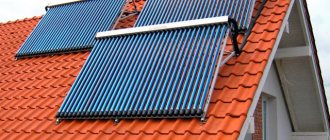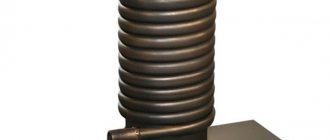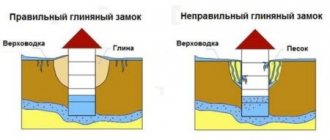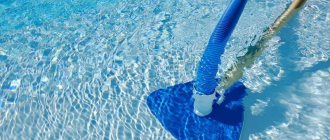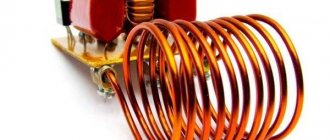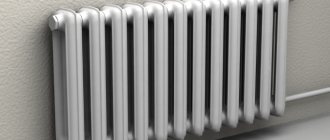What is an electrolyzer (ionizer or activator)? What is living and dead water?
Electrolyzers are often also called ionizers or water activators. But it would be more correct to call them electrolyzers, since this name reflects the essence of the processes occurring in the devices. In ionizers, water is divided into two - alkaline water with a pH greater than 8 and acidic water with a pH less than 6. Alkaline water in Russia is called “living” water, and acidic water is called “dead” water.
Water ionizer device
People have been thinking about improving water quality since ancient times. Complex, stuffed with electronics, and simple models of ionizers are used all over the world. By lowering an object made of a special metal into water, you can make the liquid “alive”; a silver water ionizer, which looks like a chain with a clothespin at one end, is built on this principle of operation. Experts are confident that silver ions can destroy pathogenic bacteria and make water healthy and tasty.
Electrolysis process
Let's return to the course of already beloved physics and chemistry. Does everyone remember the experiment with 2 sticks lowered into a container with a solution? Then they passed an electric current and talked about the so-called electrolysis process. So this very solution is called an electrolyte, there are certain requirements for it (the medium must conduct electric current), and these same sticks are called electrodes, one of which is the anode (positive charge), and the other is the cathode (negatively charged).
Electrolysis is a set of processes occurring in a solution or melt of an electrolyte when an electric current passes through it. Under the influence of direct current, the random movement of ions is ordered. Positive ions move towards the cathode, negative ions towards the anode. Ions of both signs arise in aqueous solutions of salts, acids and alkalis as a result of the splitting of some neutral molecules. This phenomenon is electrolytic dissociation.
Types of ionizers
Ionizers operate from a source of ionizing radiation (for example, ultraviolet or radioactive isotopes) or at high voltage (several thousand volts) with a corona discharge on the electrodes. In the latter case, ionizing electrodes and high-voltage power supplies, automation and safety devices are used. There are two types of ionizing electrodes: needle (point) and wire. The ion flow often reaches 1 µA, which corresponds to several billion ions per second. Arc and spark discharges are not used to ionize air, since ozone and nitrogen oxides are formed together with oxygen ions in the air.
A large number of air ionizers of various types have been created, these include:
— thermionic air ionizers by F. G. Portnov and D. L. Vilchevsky, Ya. Yu. Reinet and others, V. I. Grachev and A. K. Tuman; — radioisotope air ionizers A. B. Verigo and V. A. Poderni, Ts. I. Steinbok, “Sigma”; — radioactive air ionizers of the Institute of Nuclear Research of the Academy of Sciences of the Ukrainian SSR “IVA 1” and “IVA 2”; — photoelectric air ionizers by Ya. Yu. Reinet and A. K. Tuman; — hydrodynamic aeroionizers (hydraeroionizers) by A. A. Mikulin, E. A. Chernyavsky, D. K. Pislegin and others; — crown (effluvial) aeroionizers by D. P. Sokolov, A. L. Chizhevsky, “AIR-2”, “Riga”, “Ryazan-101”, EFA, “Zovuni”, “Aina”, “Electronics”.
Ionizers are divided into two types, depending on what types of ions they are capable of generating: unipolar ionizers - produce only negatively charged ions N2- and O2->;>+ and O2 or so-called plasma cluster ionizers, which simultaneously produce H+ and hydroxide ions HO—.
Ultraviolet air ionizers
Ultraviolet air ionizers
various sources of ultraviolet light produced exceptionally large amounts of ozone and nitrogen oxides. Just a few minutes after turning on the quartz lamp, the amount of harmful gases in the air is tens and hundreds of times greater than the permissible value. Ultraviolet ionizers are not suitable for physiological experiments.
Ultraviolet radiation, alpha, beta, gamma radiation, and X-rays also produce ions. Ultraviolet emitters were used in medical institutions for disinfection. Today they are used for purifying drinking water, curing varnishes, resins and polymers, but the main effect here is produced not by ions, but by high-energy photons, which destroy the molecules of the irradiated substance and produce the effect of destroying the surface layer.
Hydroionizers
So-called hydroionizers
— generators of electrostatically charged water mist. In the USSR, hydrodynamic “aeroionizers” of the “Comfort” type (A. A. Mikulina) were widely used, which produced a large number of water ions (but, generally speaking, did not lead to ionization of air oxygen) using distilled water. They are used to create medicinal electroaerosols and fine spraying of liquids.
Corona discharge ionizers
Ionizers of this type are equipped with pointed electrodes, which, through corona discharge and electrostatic emission, produce ions in the immediate vicinity of the electrodes. These devices come in two types:
- unregulated - they operate in a constant mode and form new ions uncontrollably;
- adjustable - change the voltage on the electrodes depending on the electric field in the environment.
Both types of ionizers are used both to obtain a certain charge and to remove or prevent unwanted electrostatic charges. To be able to place ionizers at the greatest possible distance to the discharged (charged) surface (up to 2 m), they are equipped with blowers (external or built-in) - thus, ionized air, and with it the electric charge, is supplied to the desired location (for example, in printing presses). Corona ionizers are often made in the form of comb racks; they receive power from AC or DC sources. When connecting to alternating current, all comb tips are connected; with direct current, voltages of different signs are applied to adjacent tips.
Copiers and laser printers use DC ionizers (alternating current passes through rectifiers) - the ionizers in them serve for non-contact electrostatic charging of the photo roll.
Radioisotope ionizers
Radioactive isotopes (radionuclides) are used in ionization fire sensors to detect ions of absorption substances (smoke, aerosols); in this case, the conductivity of the air is measured by ionization - the conductivity of the air increases in the presence of organic gases, fumes or aerosols in it.
Why do you need a water ionizer?
The quality of water that enters our body affects our well-being and health. Devices for water ionization are an indispensable assistant in our age of genetically modified products and neglected ecology. These devices help to “revive” the water entering our apartments through many kilometers of supply systems, improve its chemical composition for the better, increasing alkalinity. The pH of a liquid can be:
- up to 7
– an indicator characterizing an acidic environment, not saturated with oxygen; - exactly 7
– neutral environment; - above 7
is an alkaline environment, which is characterized by a high O2 content.
A generalized vision of the ionization technique under consideration
Creating a water ionizer with your own hands, of course, is impossible without a clear understanding of the basics of ionization technology. In addition, you should initially test the quality of tap water, which is supposed to be used for a homemade ionizer.
There are many liquid content testing kits on the market, however, the best way to conduct a water test is to contact a certified laboratory. The main reason for this approach (testing within the laboratory) is the accurate determination of the amount of oxygen dissolved in the liquid, plus an accurate determination of the “pH” parameter.
True, the “pH” value for the liquid under study can be determined directly at home using special (litmus) paper or using an electronic “pH” meter.
Household devices that electrolyze drinking water have been offered on the market for several years. Electrolyzers produce (separately) acidic and alkaline water (ionized). Also in practice there are other names for this type of water:
- electrolyzed reduced,
- alkaline-ionic,
- electrolyzed cathode.
Acidic water is not suitable for drinking, but is successfully used for facial and hand hygiene and body care. Alkaline water, on the other hand, is suitable for drinking, so ionizer technology is considered in commercial and marketing literature primarily as useful in the treatment of:
- gastrointestinal tract,
- hypertension,
- diabetes,
- malignant tumors.
The recommendations contained in the instructions supplied with water ionization devices recommend drinking 1.5–2.0 liters of such a product, regardless of the age, gender and health status of the consumer.
One of the many models of water ionizer for home use, made at an industrial level. Meanwhile, it is quite affordable to make a water ionizer with your own hands from available parts
Perhaps the consumption of ionized drinking liquid is truly beneficial if it actually helps relieve symptoms in patients, complementing classical methods of treatment, as some distributors of ionizers claim.
However, there may be public health concerns if ionizers are capable of causing harmful side effects in otherwise healthy people or concealing illness in apparently healthy consumers.
Types of ionizers and characteristics of produced water
The market offers many types of more or less advanced water ionizers. Most of the ionizers are made in Japan, but no less technologically advanced water ionizers are also quickly filling the market:
- U.S.A,
- Canada,
- Australia,
- China.
The average annual sales of ionizers is more than 200,000 devices priced from $600 to $3000. Meanwhile, the inventors of this kind of device (developers of the technology) are Russian scientists from the 1900s.
Technological principle of separation/purification into components
All manufactured water ionizers are connected directly to the water supply. Filtration before the ionizer is carried out through at least one filter with activated carbon, which is necessary to reduce the level of chlorides in tap water (prevent damage to the electrolytic cell of the ionizer).
GERMAN
Block diagram of connecting a classic ionizer for the production of a final product purified from impurities: 1 – tap water; 2 – primary carbon filter; 3 – secondary ceramic filter; 4 – acidic pH = 4-6; 5 – alkaline pH = 8-10
The filtered liquid allows a minimum mineral content of 50 mg * l-1. These conditions are required to produce electrolysis in a working chamber with an anode and cathode, which are separated by a semi-permeable plastic-based diaphragm. Flat (mesh) electrodes are made of titanium coated with platinum. The electrolysis process produces acid and oxidized water at the anode.
When electrons pass through an electrical circuit, mineral ions (HCO3-, Cl-, HSO4-, NO3-,...) accumulate in the anode compartment. As protons and oxygen are released, the liquid acquires a pH value of 4 to 6 and an oxidation-reduction potential that can reach +900 mV.
In contrast, reduced alkaline water is formed in the cathode compartment. For this option, mineral cations (Na +, K +, Ca2 +, Mg2 +, ...) accumulate at the cathode. As hydroxyl ions and hydrogen are formed, the pH value of the water changes from 8 to 10, and an oxidation-reduction potential of -600 mV is acceptable.
This is roughly the “picture” of the course of the chemical reaction inside the ionizer, as a result of which two types of treated liquid are obtained at the output of the device - drinking and technical
The effectiveness of the device, the resulting pH values and redox potential values vary greatly and depend on:
- on the characteristics of the local water supply,
- on voltage and current values,
- on water flow and temperature.
The effect of a water ionizer from a practical point of view
The main effect of electrolysis is a significant reduction in the rH2 value (electronic activity) compared to the original tap water, while the pH values and resistivity potential remain relatively stable.
A comparison of rH2 values with those of mineral water shows that ionized water is a highly alkaline product. Compared to conventional drinking water sources, the ionizer produces pH and Eh values that are rarely found in the natural environment.
Therefore, in scientific circles such water is usually classified as synthetic water. Regarding resistance, you can find a range from 1600 to 1700 Ohm * cm, which is stable over time and remains within the acceptable official norm of 900–5000 Ohm * cm.
In terms of pH, this range can vary digitally from 6.8 to 8.7 for a given type of equipment, and also remain relatively stable over time. By comparison, the regulatory drinking water standard recommends a pH value between 6.5 and 9.
The water ionization procedure does not lead to abnormal pH values. Regarding the redox potential, the values range from -654 to +680 mV. There are strong changes over time for negative reduction potentials and better stability for positive reduction potentials.
After adjusting for the effects of pH, rH2 (electronic activity) is between values of 2 and 45. These numbers mean that water ionizers can effectively produce oxidized water, or vice versa, water is an antioxidant.
What processes occur in the electrolyzer?
As the name suggests, the process of electrolysis occurs in the electrolyser. Electrolysis is the decomposition of a substance into its components using an electric current. The current through chemically pure (distilled or even purer, deionized water) flows very weakly, so electrolysis of pure water is difficult. Try pouring distilled water into a household ionizer, it will not work.
Electrolysis of ordinary drinking water, for example, taken from the tap, is possible precisely due to the presence of various salts in the water, for example, calcium, sodium, magnesium, etc. For the operation of electrolyzers, it is important that there are enough salts, for which the water is additionally mineralized.
In fact, we are talking about the electrolysis of an aqueous solution of salts.
The most common salts in drinking water: bicarbonates, calcium and magnesium sulfates, sodium chloride (aka table salt). When dissolving in water, salts break up (dissociate) into ions - particles with an electrical charge. In addition, the water molecules themselves also partially dissociate into H+ and OH— In drinking water, the following “float”: - positively charged Ca2+, Mg2+, Na+, K+, H+ - negatively charged HCO3-, SO42-, Cl-, OH-. The labels of bottled water in Russia always indicate a list of ions. Under the influence of an electric field, ions begin to move towards an electrode with an opposite charge, where chemical reactions occur with them.
Let us immediately make a reservation that the electrodes must be inert, that is, during electrolysis they serve only as transmitters of electrons. The material of such electrodes does not participate in electrode processes (this could be, for example, Pt (platinum), Ir (iridium), that is, the electrodes themselves do not participate in the reaction. Otherwise, the electrode itself will react and collapse (dissolve) first: Me (metal) —> Me+ + e— before other reactions begin It is clear that electrodes made of platinum or iridium are very expensive, so they are made with a platinum coating and the quality of this coating is fundamentally important.
Because All metals whose ions are present in our drinking water - Ca, Mg, Na, K - are in the series of metal voltages to the left of aluminum inclusive, then the metal is not reduced at the cathode, but hydrogen is reduced from the water. It happens like this: At the cathode (-) 2 water molecules combine with electrons and hydrogen gas and OH— ions are formed - i.e. an alkaline environment.
K(-) 2H2O + 2e‾ → H2 + 2OH—
Several reactions occur at the anode (+): 1) Since the anion of an oxygen-containing acid (SO42-) is present, oxygen atoms from water are oxidized to oxygen molecules and hydrogen ions H+ are also formed: 2H2O - 4e → O2 + 4H+, Oxygen gas is released and an acidic environment is formed - hydrogen ions H+ 2) In our case, there is also an oxygen-free acid anion (Cl-). It is oxidized to a simple substance: chlorine gas is formed 2Cl— — 2e → Cl2
So, hydrogen gas and an alkaline environment are released on the negative electrode, and oxygen, chlorine and acidic environment gases are released on the positive electrode. Please note that chlorine is a poisonous gas.
But it is important that the reaction products will mix and react with each other.
With this mixing, hypochlorite according to the reaction: Cl2+2OH— → Cl—+ClO-H2O And then, at room temperature in an acidic solution, chlorate (hypochlorous acid compound) is formed according to the reaction: 2HClO+ClO— → ClO3—+2H+2Cl—
Electrolyzer. Types and types. Device and operation. Application
An electrolyzer is a special device that is designed to separate the components of a compound or solution using electric current. These devices are widely used in industry, for example, to obtain active metal components from ore, purify metals, and apply metal coatings to products. They are rarely used for everyday use, but are also found. In particular, devices are offered for home use that allow you to determine the contamination of water or obtain so-called “living” water.
The basis of the device’s operation is the principle of electrolysis, the discoverer of which is considered to be the famous foreign scientist Faraday. However, the first water electrolyzer was created 30 years before Faraday by a Russian scientist named Petrov. He proved in practice that water can be enriched in the cathode or anodic state. Despite this injustice, his work was not in vain and contributed to the development of technology. At the moment, numerous types of devices that operate on the principle of electrolysis have been invented and are successfully used.
What is this
The electrolyser operates thanks to an external power source that supplies electric current. In a simplified way, the unit is made in the form of a housing in which two or more electrodes are mounted. There is an electrolyte inside the housing. When an electric current is applied, the solution decomposes into the required components. Positively charged ions of one substance are directed to a negatively charged electrode and vice versa.
The main characteristic of such units is productivity. That is, this is the amount of solution or substance that the installation can process over a certain period of time. This parameter is indicated in the model name. However, it can also be influenced by other indicators: current strength, voltage, type of electrolyte, and so on.
Species and types
Based on the design of the anode and the location of the conductor, the electrolyzer can be of three types; these are units with:
- Pressed baked anodes.
- Continuous self-baking anode, as well as side conductor.
- Continuous self-baking anode, as well as an upper current conductor.
The electrolyzer used for solutions can be divided into:
- Dry.
- Flow-through.
- Membrane.
- Diaphragm.
Device
The designs of the units may be different, but they all work on the principle of electrolysis.
The device in most cases consists of the following elements:
- Electrically conductive housing.
- Cathode.
- Anode.
- Pipes designed for introducing electrolyte, as well as removing substances obtained during the reaction.
The electrodes are made hermetically sealed. They are usually presented in the form of cylinders that communicate with the external environment using pipes. Electrodes are made of special conductive materials. A metal is deposited on the cathode or ions of separated gas are directed to it (during the splitting of water).
In the non-ferrous industry, specialized units for electrolysis are often used. These are more complex installations that have their own characteristics. Thus, an electrolyzer for the separation of magnesium and chlorine requires a bath made of end and longitudinal walls. It is lined with refractory bricks and other materials, and is also divided by a partition into a compartment for electrolysis and a cell in which the final products are collected.
The design features of each type of such equipment make it possible to solve only specific problems that are related to ensuring the quality of the released substances, the speed of the reaction, the energy intensity of the installation, and so on.
Operating principle
In electrolysis devices, only ionic compounds conduct electric current. Therefore, when the electrodes are lowered into the electrolyte and the electric current is turned on, an ionic current begins to flow in it. Positive particles in the form of cations are directed to the cathode, for example, hydrogen and various metals. Anions, that is, negatively charged ions flow to the anode (oxygen, chlorine).
When approaching the anode, the anions lose their charge and become neutral particles. As a result, they settle on the electrode. Similar reactions occur at the cathode: cations take electrons from the electrode, which leads to their neutralization. As a result, cations are deposited on the electrode. For example, when water splits, hydrogen is formed, which rises to the top in the form of bubbles. To collect this gas, special pipes are constructed above the cathode. Through them, hydrogen enters the required container, after which it can be used for its intended purpose.
The principle of operation in the designs of different devices is generally similar, but in some cases there may be their own characteristics. Thus, in membrane units, a solid electrolyte is used in the form of a membrane, which has a polymer base. The main feature of such devices lies in the dual purpose of the membrane. This layer can transport protons and ions, including separating electrodes and the final products of electrolysis.
Diaphragm devices are used in cases where diffusion of the end products of the electrolysis process cannot be allowed. For this purpose, a porous diaphragm is used, which is made of glass, asbestos or ceramics. In some cases, polymer fibers or glass wool can be used as such a diaphragm.
Application
Electrolyzers are widely used in various industries. But, despite its simple design, it has various designs and functions. This equipment is used for:
- Extraction of non-ferrous metals (magnesium, aluminum).
- Obtaining chemical elements (decomposition of water into oxygen and hydrogen, production of chlorine).
- Wastewater treatment (desalting, disinfection, disinfection from metal ions).
- Processing of various products (demineralization of milk, salting of meat, electroactivation of food liquids, extraction of nitrates and nitrites from vegetable products, extraction of protein from algae, mushrooms and fish waste).
In medicine, installations are used in intensive care to detoxify the human body, that is, to create high-purity sodium hypochlorite solutions. For this purpose, a flow-type device with titanium electrodes is used.
Electrolysis and electrodialysis plants are widely used to solve environmental problems and desalinate water. But these units are rarely used due to their shortcomings: the complexity of the design and their operation, the need for three-phase current and the requirement for periodic replacement of electrodes due to their dissolution.
Such installations are also used in everyday life, for example, to obtain “living” water, as well as to purify it. In the future, it is possible to create miniature units that will be used in cars to safely produce hydrogen from water. Hydrogen will become a source of energy, and the car can be fueled with ordinary water.
Related topics:
- Desalinators. Types and device. Job. Advantages and disadvantages
- Filters for air purification. Types and features. Design and operation
How to use a water ionizer?
Many have noticed that water after some filters becomes tasteless, while others change its composition so much that it is impossible to drink from it. The correct operation of a household water ionizer is of great importance in the quality of the output liquid.
- The device should be carefully inspected before switching on.
- If the device is connected to the water supply system, it is better to entrust this to specialists.
- In the model - a jug, you should pour water of a strictly designated volume.
- If the water ionizer is plugged into a power outlet, it must be installed on a flat surface and protected from children.
- Regular replacement of filters is a prerequisite to guarantee clean liquid.
- The ionizer should be washed when it becomes dirty with dishwashing detergents using a soft cloth, thoroughly rinsing the device parts with water.
Obtaining acidic (dead) water
Dead water (pH 2.5-6) may seem slightly sour in taste, especially if several hours have passed after ionization. It smells the same. It has a slight smell of chlorine. This water should not be used for daily drinking. This water is the result of electrolysis. It is completely safe and absolutely non-toxic. But this water is dead, because there are absolutely no bacteria in it. In some cases, it can cause heartburn and intestinal problems as it reacts with gastric juice.
By taking this water you can eliminate high blood pressure, improve sleep, and calm your nerves. This acidic water is a natural disinfectant. Can destroy bacteria, fungi, microbes. In some countries, scientists are confident that regular consumption of such water can prevent the occurrence of cancer. But this theory has not been proven or disproved.
Using ionized water (living and dead) in turn, you can cure respiratory diseases, get rid of allergic reactions, and also prevent the appearance of various viral diseases.
Particularly pure water with silver ions
The purest water, which is saturated with silver ions. Not only can it destroy harmful bacteria and microbes, such water can act as a bactericide, while stimulating the functioning of all processes in the body.
It has long gained its popularity and if earlier it was difficult to obtain such water, then with the help of the Aqualife device silver water will be ready in a few minutes.
Important! Not all silver is healthy, but the ionization process in this device makes truly high-quality water that will be beneficial to your health. It contains no additives, stabilizers or preservatives.
Silver water can improve immunity, destroy bacteria, and heal damaged tissue. It is considered the best way to kill bacteria. This water is now used all over the world.
Types of electrolyzers
Let's briefly look at the design features of the main types of water splitting devices.
Dry
The design of a device of this type was shown in Figure 2; its peculiarity is that by manipulating the number of cells, it is possible to power the device from a source with a voltage significantly exceeding the minimum electrode potential.
Flow-through
A simplified design of devices of this type can be found in Figure 5. As you can see, the design includes a bath with electrodes “A”, completely filled with solution and a tank “D”.
Figure 5. Design of a flow electrolyzer
The operating principle of the device is as follows:
- at the entrance of the electrochemical process, the gas together with the electrolyte is squeezed into container “D” through pipe “B”;
- in tank “D” gas is separated from the electrolyte solution, which is discharged through the outlet valve “C”;
- the electrolyte returns to the hydrolysis bath through pipe “E”.
Membrane
The main feature of devices of this type is the use of a solid electrolyte (membrane) on a polymer basis. The design of devices of this type can be found in Figure 6.
Figure 6. Membrane-type electrolyzer
The main feature of such devices is the dual purpose of the membrane: it not only transfers protons and ions, but also physically separates both the electrodes and the products of the electrochemical process.
Diaphragm
In cases where diffusion of electrolysis products between the electrode chambers is not permissible, a porous diaphragm is used (which gives such devices their name). The material for it can be ceramics, asbestos or glass. In some cases, polymer fibers or glass wool can be used to create such a diaphragm. Figure 7 shows the simplest version of a diaphragm device for electrochemical processes.
Design of a diaphragm electrolyser
Explanation:
- Oxygen outlet.
- U-shaped flask.
- Hydrogen outlet.
- Anode.
- Cathode.
- Diaphragm.
Alkaline
The electrochemical process is impossible in distilled water; a concentrated alkali solution is used as a catalyst (the use of salt is undesirable, since this releases chlorine). Based on this, most electrochemical devices for splitting water can be called alkaline.
On thematic forums, it is advised to use sodium hydroxide (NaOH), which, unlike baking soda (NaHCO3), does not corrode the electrode. Note that the latter has two significant advantages:
- Iron electrodes can be used.
- No harmful substances are released.
But one significant drawback negates all the benefits of baking soda as a catalyst. Its concentration in water is no more than 80 grams per liter. This reduces the frost resistance of the electrolyte and its current conductivity. If the first can still be tolerated in the warm season, then the second requires an increase in the area of the electrode plates, which in turn increases the size of the structure.
Detailed instructions for using the device
Before you start using the ionizer, you should:
- remove the top cover of the device,
- insert bowls,
- The cord must be plugged into the outlet and press the power button.
- A note will appear on the screen indicating whether everything is connected correctly.
- After this, you will be prompted to enter the required pH level.
- By pressing the Start button you will start the ionization process.
The lid handle and the handle on the main vessel should form one piece.
You can connect the device to the network only when you have poured water and tightly closed the lid.
The device will independently select the time for operation and turn off when ionization is complete. If you need to interrupt the process earlier, you should click on the Stop button.
Important! When the work process is completed, the device itself will give a signal and turn off.
After you have extracted the finished water, you should thoroughly wash the vessels and dry them for next use. It is very important to follow the sequence of all operations and handle all components carefully.
Exploitation
- You can use tap water to prepare purified water. You can also use spring water, but its pH may differ, which will affect further cleansing.
- The first water you prepare should be thrown away and not used.
- It is not recommended to replace the membrane and filter yourself. If the membrane fails, it should be replaced immediately. All parts must be used carefully, without using brute force.
- Handle the electrodes carefully; if the electrode is damaged, it must be replaced. Electrodes should not be washed or rubbed with a sponge. After drying the device, you can lightly wipe it with a dry cloth.
Safety precautions
The following rules should be observed:
- The device can only be connected when there is water in the containers and it is tightly closed with a lid;
- It is forbidden to remove the cover when the device is operating;
- do not place the switched on ionizer near a fire;
- You cannot disassemble the device and repair it yourself.
If you are going to repair the device yourself, this prohibits you from using the warranty card in the event of a breakdown due to the high risk of damage to parts.
Competent care
Proper operation requires proper maintenance. To do this, it is necessary to thoroughly rinse the ionizer after each use. It is not recommended to use chemical cleaners; it is better to rinse thoroughly, but if plaque has formed, you can remove it with soda.
The device should not be left unattended and kept away from children.
Electrolyzer from Watertest
The electrolyzer is designed to visually demonstrate the difference in the quality of water taken from two sources. You can compare the quality of tap water and drinking water. As a result of the electrolysis process, the level of mineralization of water in the form of oxidizing metals and minerals present in the water is clearly demonstrated. the electrolyzer shows the presence or absence of soluble salts. If you use one pair of electrodes, or one container, then only one source of liquid can be examined for impurities.
By purchasing electrolyser , you can control the water that your supplier provides you.
Go to product
